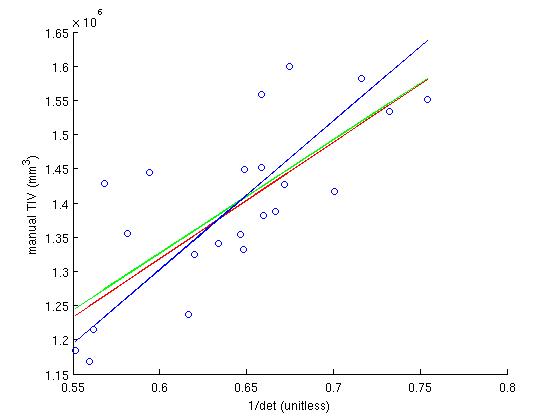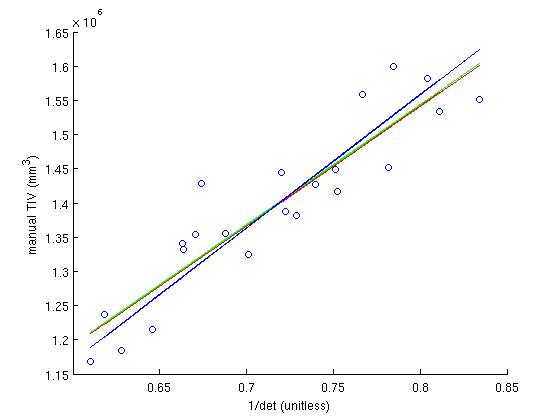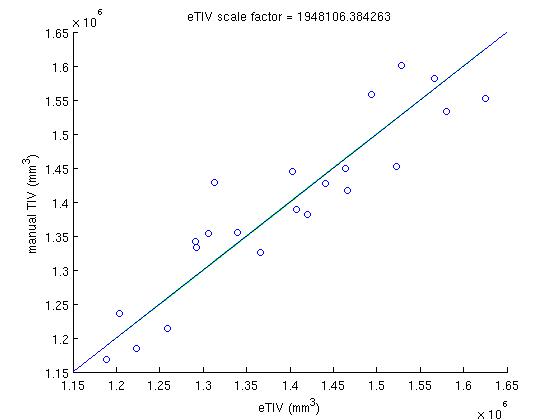eTIV - estimated Total Intracranial Volume, aka ICV
Intro
The estimated total intracranial volume (ICV) calculation is based on this work:
A unified approach for morphometric and functional data analysis in young, old, and demented adults using automated atlas-based head size normalization: reliability and validation against manual measurement of total intracranial volume Buckner et al. (2004) NeuroImage 23:724-738.
Basically, total intracranial volume is found to correlate with the determinant of the transform matrix used to align an image with an atlas. The work demonstrates that a one-parameter scaling factor provides a reasonable TIV estimation.
Usage
The Freesurfer binaries that calculate eTIV are mri_segstats and mri_label_volume.
recon-all automatically calls mri_segstats, putting the eTIV (also called ICV) in the <subj>/stats/aseg.stats file. Here is an example output line from an aseg.stats file:
# Measure IntraCranialVol, ICV, Intracranial Volume, 2053447.999698, mm^3
mri_segstats hard-codes the transform file used to extract the determinant, and hard-codes the scale factor (see Methods section below for details). To have mri_segstats output just the eTIV:
mri_segstats --subject subjid --etiv-only
In constrast, mri_label_volume requires specifying the transform file to use, and the scale factor:
mri_label_volume -eTIV \ $sdir/transforms/talairach.xfm 1948 \ $sdir/aseg.mgz 17 53
where $sdir is the path to the subject's mri directory (ie, $SUBJECTS_DIR/<subjid>/mri). The '17' and '53' are label ID's, in this case left and right hippocampus (see the subjects /stats/aseg.stats file for IDs). The output will look like:
using eTIV from atlas transform of 1528 cm^3 processing label 17... 3822 voxels (3822.0 mm^3) in label 17, %0.250119 of eTIV volume (1528075) processing label 53... 4410 voxels (4410.0 mm^3) in label 53, %0.288598 of eTIV volume (1528075)
Here, the eTIV is 1528075mm^3.
To check the quality of the registration file talairach.xfm file:
cd $SUBJECTS_DIR/subject/mri/transforms tkregister2 --xfm talairach.xfm \ --targ $FREESURFER_HOME/average/RB_all_withskull_2008-03-26.gca \ --mov ../nu_noneck.mgz --reg junk
Methods
The Buckner et al. paper, referenced above, demonstrates that atlas normalization using appropriate template images provides an automated method for head size correction that is equivalent to manual TIV correction. To implement this work in Freesurfer, three elements are necessary: an appropriate template atlas, normalization to that template, and a scaling factor. In Freesurfer, there are at least two options for a 'template atlas', and accompanying 'normalization' (or transform) to that atlas. One option, used in Freesurfer v4.2.0 and earlier, is to use the atlas file $FREESURFER_HOME/average/RB_all_withskull_2008-03-26.gca and the registration to that atlas found in $SUBJECTS_DIR/subjid/mri/transforms/talairach_with_skull.lta (created by mri_em_register). The other option, that used in Freesurfer v4.2.1 and later, is to use the atlas $FREESURFER_HOME/average/711-2C_as_mni_average_305.4dfp.img and the registration to that atlas found in $SUBJECTS_DIR/subjid/mri/transforms/talairach.xfm (created by talairach_avi).
To determine the scaling factor, 22 subjects for which the TIV has been determined manually via their T2-weighted scans (which clearly show the skull), are used as the training set. These subjects are found in /autofs/space/jc_001/users/nicks/subjects/SASHA. The scaling factor is determined analytically by first generating the determinant of the atlas transform for the 22 subjects, plotting this against each subjects manual TIV, fitting a line to this, and calculating the scale factor from the slope.
In that SASHA directory, in the the scripts directory, the script run_rb_xfm.csh will run the mri_label_volume binary and generate a matlab data file called det_eTIV_matdat.m which contains the determinant and eTIV data. Then, the matlab script plot_inv_det.m plots the inverse determinant against the manual TIV, finds the best fit to this plot, calculates the scale factor from that fit and then plots the eTIV against manual TIV, for each subject using that scaling factor. The file ICVnative_matdat.m contains the manual TIV data, copied from the ICVnative column in the file buckner_tiv.txt, which originates from the people performing the manual TIV measurements.
The red line in the plot is the best fit to the points, and validates the assumption that there is a simple linear correlation between TIV and a single parameter (the determinant of the transform matrix aligning the subject to an atlas).
The eTIV vs manual TIV plot has a unity slope line which is the ideal (the blue line), that is, estimated TIV exactly equals the true (manually determined) TIV. The best fit line, in red, shows how close to ideal the variable 'eTIV_scale_factor' is doing to match this line.



